Back to the Index page
Wharram and Fordon 22nd June 2004
led by Nan Sykes (species lists below)
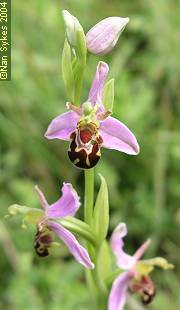 Ten members met at the car park in Norton for this trip to the chalk of the East Riding on a fine day:
sunny but with a cool westerly breeze, and some small cumulus clouds later in the afternoon. Chalk is,
of course, a form of limestone, and supports a characteristic suite of wildflowers such as rock-roses,
wild thyme, field scabious and orchids. There is sadly very little semi-natural downland remaining on
the Wolds, but many of the flowers have survived in pockets such as old quarries.
Ten members met at the car park in Norton for this trip to the chalk of the East Riding on a fine day:
sunny but with a cool westerly breeze, and some small cumulus clouds later in the afternoon. Chalk is,
of course, a form of limestone, and supports a characteristic suite of wildflowers such as rock-roses,
wild thyme, field scabious and orchids. There is sadly very little semi-natural downland remaining on
the Wolds, but many of the flowers have survived in pockets such as old quarries.
Wharram
The first stop was at the YWT reserve at Wharram Quarry which is renowned for its flora. We were not
disappointed. The site consists of the old quarry with an extensive flat floor, steep banks running
along behind this, and scrubby woodland around the edges and along the roadside. Perhaps the most exciting
find was the bee orchids – not that they were hard to find, indeed one had to be very careful not
to stand on them as there were so many flowering spikes, with up to five flowers on each though two
or three was more usual. I have never seen these beautiful flowers in bloom in Britain before. Each
spike was about 6" tall, and from a distance of a couple of feet or more the furry lower lip of
the flower really did look like a bumble bee visiting a 3-petalled purple flower. From close range they
were quite fascinating and very beautiful (left).
The floor of the quarry was almost like an alpine garden, with many tiny plants such as fairy flax,
scarlet pimpernel (right), wild thyme and birdsfoot trefoil together with taller species such
as rough hawkbit and quaking grass (a real lime-lover). Rather to my surprise there were very few
rock-roses growing here, either on the quarry floor or the steep stony banks that form the back wall.
The site is managed to encourage a wide variety of flora, and this involves scraping some areas almost
bare of soil, and leaving others with a thicker covering. This leads to a patchwork effect, with each
area having its own distinct plant assemblage. One of these had a wonderful show of clustered bellflowers.
This is a plant that is now rare in its wild form. The specimens here varied from a
mere 3" tall with about three flowers to almost a foot high with 10 or so flowers in a terminal
cluster plus others lower down the stem – almost as showy as the garden variety! Towards the old quarry
buildings the vegetation is taller, with shrubs such as roses and small trees including hawthorn. We
also found both pyramidal and common spotted orchids here, the latter growing in profusion on one small bank together with rough hawkbit (Leontodon hispidus) which is superficially like a tall dandelion. There were many other plants here, including the leaves of the splendid woolly thistle that will flower in a month or so, and one
or two surprises such as the yellow hayrattle that is normally associated with damper, less alkaline
conditions.
Fordon Bank

After lunch we headed east to Fordon Bank, another YWT reserve, this time on a steep south-facing
hillside near Wold Newton. This bank is a rare survival of herb-rich downland grass, kept cropped to
a large degree by rabbits, although cattle also graze the hillside. The flora is in many ways similar
to that at Wharram, although there are more and taller grasses, as well as some development of scrub
(mostly hawthorn and elder). There were yellow rock-roses everywhere (which were conspicuous by their
absence at Wharram which was a surprise), with wild thyme, birdsfoot trefoil, quaking grass and many
other plants. We also found the clustered bellflower here, as well as field mouse-ear, hop trefoil (another
surprise), dropwort, one plant of kidney vetch, field scabious and the leaves of hairy violet under
some trees. Perhaps the most striking flowers were the numerous nodding or musk thistles with their
fragrant heads almost 2" across. There were also numerous plants of the curious carline thistle,
but these were not yet in flower. Surprisingly the only orchid we found was one poor specimen of common
spotted, which I suspect the rabbits had chewed – perhaps this is why there were no others? In
addition to the plants on the reserve itself there was an interesting corner of unsprayed arable land
by the roadside which had typical “weeds” including a wonderful show of poppies but also, more
interestingly, a good many plants of Venus’ looking glass (Legousia hybrida), scarlet pimpernel,
field pansy and sun spurge. Unfortunately I found the Legousia almost impossible to photograph
(the flowers are only about 3mm across), but I have included a picture here as it is somewhat of a rarity.
The field pansy was much bluer than the typical form which is uniformly cream, at least in this part
of Yorkshire.
Venus’ looking glass
 |
Field mouse-ear
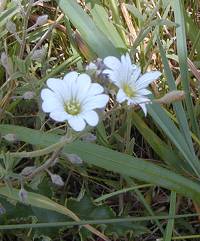 |
Field pansy
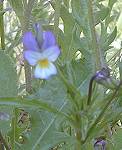 |
Insects
Given the wonderful variety of flowers, it was no surprise to see plenty of butterflies and colourful
moths, as well as bees and flies, at both sites. Unfortunately I am not an expert and could not identify
many of them but they did include common blue, small heath, meadow brown, marbled white, ringlet and
painted lady butterflies, cinnabar moth and a burnet moth caterpillar as well as the attractive black-and-white Wood Tiger
moth (thanks to Stuart Dunlop for the identifications). All the specimens below were about ¾"
(2cm) long.
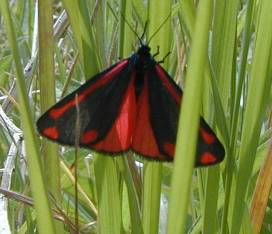 |
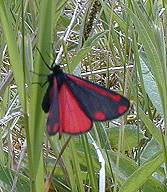 |
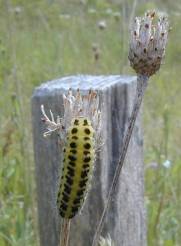 |
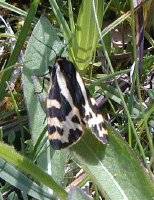 |
| Cinnabar Moth |
Cinnabar Moth |
Burnet Moth Caterpillar |
Wood Tiger Moth |
Birds
I did not see many birds although I did hear several different species. I think perhaps the botanists
were making too much noise, and all the birds kept a low profile in the trees and bushes. Tom Denney
has kindly provided the list below.
Warblers: chiffchaff, willow warbler, whitethroat, blackcap.
Hirundines: swallow, house martin, swift.
Others: yellowhammer, greenfinch, chaffinch, linnet, wren, blackbird, corn bunting (on wires
en route to Fordon), wood pigeon, stock dove, collared dove, kestrel, rook, magpie, jackdaw.
(on village pond en route): mallard & Canada geese.
Mammals
Apart from the ubiquitous rabbits, we saw one hare at Wharram, and a fox cub at Fordon.
Gill Smith, June 2004
Plant lists
This is not a complete list, and only contains those grasses that I could identify easily. One or two
of the plants were only noted as leaves (e.g. cowslip, hairy violet). I have produced separate lists
for the two sites, but clearly there is an enormous overlap.
Wharram Quarry (64spp.)
| Latin |
English |
| Acer pseudoplatanus |
Sycamore |
| Achillea millefolium |
Yarrow |
| Anacamptis pyramidalis |
Orchid, pyramidal |
| Anagallis arvensis |
Scarlet pimpernel |
| Anthriscus sylvestris |
Cow parsley |
| Arabis hirsuta |
Hairy rock-cress |
| Arrhenatherum elatius |
Oat, False |
| Brachypodium sylvaticum |
Slender False Brome |
| Briza media |
Quaking Grass |
| Campanula glomerata |
Clustered Bellflower |
| Carex flacca |
Glaucous sedge |
| Carlina vulgaris |
Thistle, carline |
| Centaurea nigra |
Knapweed, common |
| Centaurea scabiosa |
Knapweed, greater |
| Cerastium glomeratum |
Mouse ear, sticky |
| Chamaenerion angustifolium |
Willowherb, rosebay or Fireweed |
| Cirsium eriophorum |
Thistle, woolly |
| Cirsium vulgare |
Thistle, spear |
| Crataegus monogyna |
Hawthorn |
| Crepis capillaris |
Hawksbeard, smooth |
| Cruciata laevipes |
Crosswort |
| Dactylorhiza fuchsii |
Orchid, common spotted |
| Euphrasia officinalis agg. |
Eyebright |
| Fraxinus excelsior |
Ash |
| Galium verum |
Bedstraw, lady’s |
| Gentianella amarella |
Gentian, autumn |
| Heracleum sphondylium |
Hogweed |
| Hieracium species |
Hawkweed |
| Holcus lanatus |
Yorkshire Fog |
| Knautia arvensis |
Scabious, field |
| Lamium album |
Deadnettle, white |
| Lathyrus aphasa |
Yellow vetchling |
| Lathyrus pratensis |
Meadow vetchling |
| Leontodon hispidus |
Hawkbit, rough |
| Leucanthemum vulgare |
Oxeye daisy or Dog Daisy |
| Linum catharticum |
Flax, fairy |
| Lotus corniculatus |
Birdsfoot trefoil, common |
| Medicago lupulina |
Medick, black |
| Ononis repens |
Restharrow, common |
| Ophrys apifera |
Orchid, bee |
| Pilosella officinarum |
Hawkweed, mouse eared |
| Plantago lanceolata |
Plantain, ribwort |
| Plantago major |
Plantain, greater |
| Plantago media |
Plantain, hoary |
| Polygala serpyllifolia |
Milkwort, heath |
| Polygala vulgaris |
Milkwort, common |
| Primula veris |
Cowslip |
| Prunella vulgaris |
Self heal |
| Quercus sp. |
Oak |
| Ranunculus repens |
Buttercup, creeping |
| Reseda luteola |
Weld |
| Rhinanthus minor |
Yellow rattle |
| Rosa canina |
Rose, dog |
| Rubus fruticosus |
Bramble |
| Rubus idaeus |
Raspberry |
| Sambucus nigra |
Elder |
| Sanguisorba minor |
Burnet, salad |
| Senecio jacobea |
Ragwort, common |
| Thymus polytrichus |
Thyme |
| Trifolium pratense |
Clover, red |
| Trifolium repens |
Clover, white |
| Tussilago farfara |
Coltsfoot |
| Veronica chamaedrys |
Speedwell, germander |
| Vicia cracca |
Vetch, tufted |
Fordon (78 spp.)
| Latin |
English |
| Achillea millefolium |
Yarrow |
| Anagallis arvensis |
Scarlet pimpernel |
| Anthyllis vulneraria |
Vetch, kidney |
| Aphanes arvensis |
Parsley piert |
| Arabis hirsuta |
Hairy rock-cress |
| Arenaria serpyllifolia |
Thyme leaved sandwort |
| Bellis perennis |
Daisy |
| Briza media |
Quaking Grass |
| Bromus erectus (Bromopsis erecta) |
Brome, Upright |
| Campanula glomerata |
Clustered Bellflower |
| Capsella bursa-pastoris |
Shepherd’s purse |
| Carduus nutans |
Thistle, musk |
| Carlina vulgaris |
Thistle, carline |
| Cerastium arvense |
Mouse ear, field |
| Cerastium fontanum |
Mouse ear, common |
| Cerastium glomeratum |
Mouse ear, sticky |
| Chaerophyllum temulem |
Rough chervil |
| Cirsium arvense |
Thistle, creeping |
| Cirsium vulgare |
Thistle, spear |
| Convolvulus arvensis |
Bindweed, field |
| Crataegus monogyna |
Hawthorn |
| Crepis capillaris |
Hawksbeard, smooth |
| Dactylis glomeratus |
Cocksfoot grass |
| Dactylorhiza fuchsii |
Orchid, common spotted |
| Euphorbia helioscopia |
Spurge, sun |
| Euphrasia officinalis agg. |
Eyebright |
| Filipendula ulmaria |
Meadowsweet |
| Filipendula vulgaris |
Dropwort |
| Fumaria sp. |
Fumitory |
| Galium aparine |
Cleavers |
| Geranium dissectum |
Cranesbill, cut leaved |
| Geum urbanum |
Avens, wood |
| Helianthemum nummularium |
Rockrose |
| Knautia arvensis |
Scabious, field |
| Lamium amplexicaule |
Deadnettle, henbit |
| Lathyrus pratensis |
Meadow vetchling |
| Legousia hybrida |
Venus’s looking-glass |
| Leontodon hispidus |
Hawkbit, rough |
| Leucanthemum vulgare |
Oxeye daisy or Dog Daisy |
| Lolium multiflorum |
Rye Grass, Italian |
| Lotus corniculatus |
Birdsfoot trefoil, common |
| Matricaria discoidea |
Pineapple weed |
| Myosotis arvensis |
Forgetmenot, field |
| Odontites verna |
Red bartsia |
| Ononis repens |
Restharrow, common |
| Papaver rhoeas |
Poppy, common |
| Phleum bertolonii |
Catstail |
| Phleum pratense |
Timothy |
| Plantago lanceolata |
Plantain, ribwort |
| Plantago media |
Plantain, hoary |
| Polygala vulgaris |
Milkwort, common |
| Potentilla reptans |
Cinquefoil, creeping |
| Primula veris |
Cowslip |
| Prunella vulgaris |
Self heal |
| Ranunculus repens |
Buttercup, creeping |
| Rosa canina |
Rose, dog |
| Rumex acetosa |
Sorrel, common |
| Rumex crispus |
Dock, curled |
| Sambucus nigra |
Elder |
| Sedum acre |
Stonecrop, biting |
| Sherardia arvensis |
Field madder |
| Silene dioica |
Campion, red |
| Silene latifolia |
Campion, white |
| Silene vulgaris |
Campion, bladder |
| Sisymbrium officinalis |
Hedge mustard |
| Sonchus asper |
Sowthistle, rough |
| Thymus polytrichus |
Thyme |
| Trifolium campestre |
Trefoil, hop |
| Trifolium dubium |
Trefoil, lesser |
| Trifolium pratensis |
Clover, red |
| Trifolium repens |
Clover, white |
| Ulex europaeus |
Gorse |
| Urtica dioica |
Nettle, common |
| Veronica arvensis |
Speedwell, wall |
| Veronica chamaedrys |
Speedwell, germander |
| Veronica persica |
Speedwell, common |
| Viola arvensis |
Pansy, field |
| Viola hirta |
Violet, hairy |
Back to the Index page
 Ten members met at the car park in Norton for this trip to the chalk of the East Riding on a fine day:
sunny but with a cool westerly breeze, and some small cumulus clouds later in the afternoon. Chalk is,
of course, a form of limestone, and supports a characteristic suite of wildflowers such as rock-roses,
wild thyme, field scabious and orchids. There is sadly very little semi-natural downland remaining on
the Wolds, but many of the flowers have survived in pockets such as old quarries.
Ten members met at the car park in Norton for this trip to the chalk of the East Riding on a fine day:
sunny but with a cool westerly breeze, and some small cumulus clouds later in the afternoon. Chalk is,
of course, a form of limestone, and supports a characteristic suite of wildflowers such as rock-roses,
wild thyme, field scabious and orchids. There is sadly very little semi-natural downland remaining on
the Wolds, but many of the flowers have survived in pockets such as old quarries.
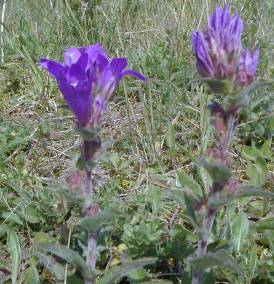
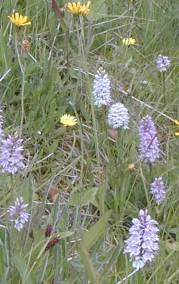

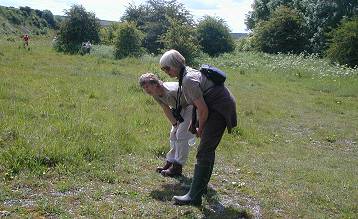 Two members admiring the “rock garden”
Two members admiring the “rock garden”






